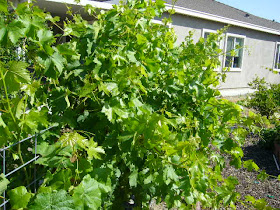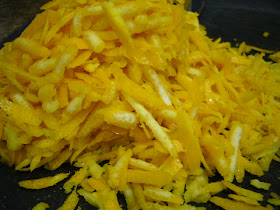 |
| Table Grape Vines in Need of a Haircut |
Springtime means big time projects in the Bird Back 40. Yes -- it also means gardening -- but it can also involve prepping for the upcoming summer fresh fruit season. If you had the pleasure of growing up in the Central San Joaquin Valley, you've had the pleasure of tasting some of the best fruit that our hot, dry summers have to offer. I am sometimes amazed by the bounty of fruit and produce that this valley produces, from southern Kern County to northern Shasta County.
Short and sweet? We can grow just about everything here. We help feed the entire nation when it comes to some crops. We're spoiled. And I like it that way!
 |
| Warning! Pruning Job Ahead! |
One crop that grows particularly well in this valley? Grapes! Not just any grapes mind you -- but my favorite: The Table Grape. California leads the nation in both wine and table grape production. Wine grapes get most of the ink because this nation has a never-ending love affair with all things wine. I find it strange that I never did develop a taste for vino. After all, I love grapes. It should make sense, then, that I would love wine. Right?
Wrong. I can't stand the taste of wine. I love grape juice. I absolutely love any type of cider made from pomegranates, pears, apples, etc. But I can't do wine.
Color me strange.
 |
| Venus and Audrey with Fantasy Table Grapes |
We are now headed into the fourth year of table grape production in the Bird Back 40. Last year was simply off the hook in terms of table grape production, even though I probably lost 40% to 50% of the crop to a scourge called powdery mildew. Even though I have no problem using controls to combat this problem, I discovered too late last season that the product I had been using protects against a bevy of diseases, except powdery mildew. By the time I finally did procure the right controls? It was already too late.
I won't have that problem this year.
I always encourage others to grow grapes in a backyard or side yard or even turn part of a front yard into a productive and pretty arbor. They're easy to grow and deliver a tasty snack for months on end. But if there's one thing I've learned? Grape vines need care. The more you care for them? The better they will be to you in terms of a tasty harvest. I've also come to discover that field hands who do this dirty work of tending vines deserve hazard pay. This isn't an easy task.
 |
| Red Suffolk Table Grapes Protected by Bird Netting |
There are a multitude of ways to prune grape vines. It seems like commercial growers are always coming up with one ingenious way or another to prune a vine so it will provide a fatter harvest. The better the harvest? The better the profit margin!
In my case? I practice two tried and true forms of pruning: Spur pruning and Cane pruning. I find spur pruning works best with some varieties of table grapes, while cane pruning works better with others. In some cases? With some varieties like the Black Monukka? It really doesn't matter. The Black Monukka is going to deliver a whopper harvest no matter how it's pruned. Simply put? The Black Monukka is one of the best tasting table grapes that you can plant in your backyard.
 |
| Marquitos Points Out Two Year Old Wood |
The fruit for this year's harvest is going to come from the spurs or canes that emerged during last year's growing season. It's the first-year wood that you're looking to save during the "shave and a haircut" process. While I've discovered, by accident mind you, that two year old wood will also produce fruit, it won't produce as much as the first-year wood.
Some table grape varieties will produce a multitude of new canes during the growing season. Some don't. For those that don't produce a lot of new canes during the growth season? I practice spur pruning. And then there are others like Fantasy and Flame that produce so many new shoots during the spring and summer that it's tough to decide what to keep and what to completely prune away.
 |
| Partially Trimmed Vines |
Spotting the two year old vines is easy enough. First, the wood is a bit darker. Secondly, it's wood that I tied to my grape vine trellis with green stretchy tape last year. This is wood that I will want to completely cut away as it served as last year's fruiting canes. They aren't needed anymore.
The second step is locating and keeping the fattest and thickest canes that emerged from the trunk of the vine the previous season. With some vines, it's obvious. With others? Not so much. When it comes to spur pruning a vine, one only needs to keep two of the strongest canes that emerged the previous season. Sometimes you have ten to choose from, which means you're doing a lot of cutting.
 |
| Vines Pruned and Tied to Trellis |
The Flame table grape variety, for example, must have produced 20 new shoots last season. It was probably the fastest growing vine out of the bunch. But I could only keep three of the best branches, which means 17 others got pruned away along with the old wood.
Another thing to watch out for? Bending a particular branch in one way or another can result in a whipping motion that leaves a nice little red welt on your face or neck. Remember what I told you about field hands and hazard pay?
But, the moment finally does come when you've completely pruned each vine and kept only the best canes. These are the canes that will serve as this year's fruit producers. The job isn't quite done yet. These canes need to be tied down, or trained, to move in one direction or another. Sometimes they don't want to move in the direction you want them to move in. They will remind you of this when slapping you across the face once you've made the mistake of letting go of a vine before you've got it tied down. Or sometimes that green stretchy tape snaps. Oh, the horror.
 |
| Vines in Springtime |
There comes a time, however, when the job is finished. The canes and spurs are tied down against the trellis. The vines have been fertilized. Everything looks neat and tidy. You're ready for the new season.
As for the numerous canes that were pruned away and are now lying on the ground? Those serve a purpose as well. This is how you start new vines. Simply cut a section of vine about a foot long, stick it in a pot with a bit of soil. And, with any luck, that vine will begin to produce roots below the soil line and green shoots above. I farmed out a number of cuttings to people connected with the Sacramento Chapter of the California Rare Fruit Growers (CRFG). I even had one request for canes from a grower in Chicago, IL.
 |
| Red Suffolk Table Grapes (Delicious) |
Will California vines grow in a Chicago backyard? Good question. I don't really know. But a grower is willing to give it a try. Gardening really is an exercise in trial and error. Mistakes by the dozens are made in this journey.
But when you find yourself munching on a plate of fat and juicy Red Flame grapes this summer? It's well worth it.
































